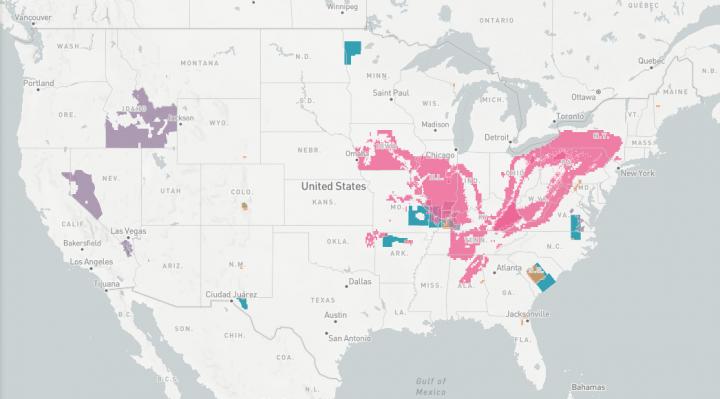A total of $7.97 million will fund new research and preserve important data across the Nation

Credit: USGS
The U.S. Geological Survey and the Association of American State Geologists are pleased to announce the projects that have received funding for FY2020 under the USGS Mineral Resources Program’s Earth Mapping Resources Initiative, or Earth MRI. New projects in 21 states will receive $7.97 million in funding in fiscal year 2020 to improve the Nation’s mapping of shallow and deep geology.
The State Geological Surveys will receive $2.36 million in support of new geologic mapping and geochemistry, $3.1 million will be devoted to new airborne geophysical survey projects in parts of nine states, and $1.75 million for a lidar survey in Nevada. In addition, 27 State Geological Surveys will receive a total of $762,000 to help with preserving geologic data to better understand the critical mineral resources of the Nation.
“These new projects, in states all across the country, represent the next step in our ambitious effort to improve our knowledge of the geologic framework in the United States and to identify areas that may have the potential to contain undiscovered critical mineral resources,” said Jim Reilly, director of the USGS. “The identification and prioritization of prospective areas was done in through our strong partnership with the State Geological Surveys in a series of workshops in Fall 2019.”
“This program will revitalize and update the science and geologic research and data compilation that is needed in many states for the United States to identify new geologic associations,” said John Yellich, director of the Michigan Geological Survey and incoming president of AASG.
An effort was made to select projects in States not funded in FY2019 whenever possible for geophysical surveys and geologic mapping projects to increase State Geological Survey participation and expand coverage across a broader region of the Nation.
“The Earth MRI effort is an outgrowth of the strong partnership between the AASG members and the USGS,” said Warren Day, Earth MRI lead scientist for the USGS. “The USGS is grateful for the scientific input and support from the State Geological Surveys, resulting in a robust body of information useful for many applications beyond mineral resources.”
The new data acquisition projects that received funding are partnerships between the USGS, led by the USGS Mineral Resources Program, and the relevant State Geological Surveys or equivalent agencies. These projects are divided into four types: airborne geophysical surveys, geologic mapping projects, lidar surveys, and geochemistry reconnaissance surveys.
Airborne geophysical surveys collect a combination of magnetic and radiometric data. Magnetic data can tell us the amount of magnetic minerals, primarily magnetite, in the exposed and deeply buried rocks; whereas the radiometric data indicates the relative amounts of potassium, uranium, and thorium in the exposed rocks and soils. This information allows scientists to help identify likely locations of particular rocks and geologic structures (such as faults) that can host minerals of interest, geothermal energy resources, groundwater and potential earthquake hazards in the region.
Earth MRI is investing $2.69 million in geophysical surveys that will be acquired through contracts with the private sector. The new geophysical surveys will be flown in critical mineral-bearing regions of Alaska, Colorado, Illinois, Kentucky, Minnesota, Missouri, New Mexico, North Carolina, Texas, and Virginia.
The geologic mapping efforts will refine our understanding of the geologic framework of areas of interest. In addition to helping identify mineral potential, these maps also support decisions about use of land, water, energy, and minerals and to mitigate the impact of geologic hazards on communities.
The geologic mapping projects, which are managed through the National Cooperative Geologic Mapping Program, are typically funded in the conterminous US at a total of $100,000 each and for Alaska at $600,000. The states that have received these agreements are Alaska, Arizona, Colorado, Florida, Maine, Missouri, Montana, New Mexico, Pennsylvania, Texas, Utah, and Wyoming.
Lidar is a laser-based system of scanning terrain to create high-resolution digital elevation models with vertical accuracy as good as 10 centimeters. Lidar is helpful for mineral research, because many mineral deposits have topographic signatures that provide clues to their location and content. For FY2020, the USGS is putting $1.75 million into supporting a lidar project to fill major data gaps in Nevada. This new effort is called the Geoscience Data Acquisition for Western Nevada (GeoDAWN) project, which is a multiagency partnership led by the USGS and Department of Energy that seeks to shed light on lithium and other critical mineral resource potential as well as geothermal energy potential in western Nevada The new data will be contracted to private industry through the USGS 3DEP Program.
The geochemistry reconnaissance surveys will provide information on mineral commodities in several formations that span multiple states. These projects will help geologists better define the poorly understood distribution of critical minerals in unconventional geologic settings across the eastern and central parts of the US. The states that received funding were Illinois, Indiana, Kentucky and West Virginia.
The FY2020 Earth MRI project funding includes additional support from the USGS National Cooperative Geologic Mapping and the USGS Mineral Resources Programs.
###
Earth MRI is a partnership between the USGS, State Geological Surveys, and industry to acquire new geologic maps, geophysical surveys, and LiDAR data to better understand the fundamental geologic framework of areas across the Nation with potential for hosting critical mineral resources. More information can be found here. To learn more about USGS mineral resource and commodity information, please visit our website and follow us on Twitter.
Media Contact
Alexander Demas
[email protected]
Original Source
https:/




